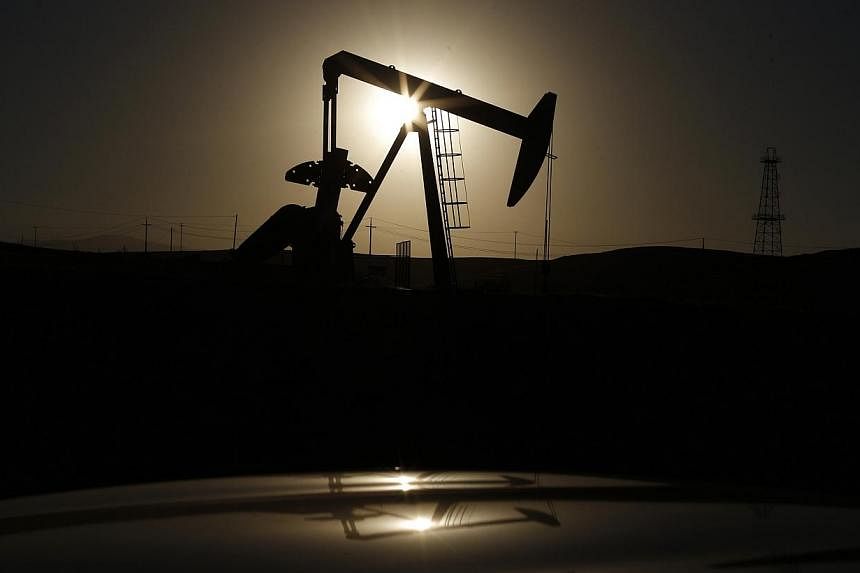After weeks of see-sawing, the bet is that stocks will get a Christmas boost in this holiday-shortened trading week to end the year on a bullish finale. Here's why:
1. The worm may have turned for oil
Investors appear to be warming up to the belief that the plunge in oil prices could be a net positive for the global economy - more certainly for the US economy.
The US stock benchmark, the Dow, plunged 200 points in the first two days of last week following crude oil's more than 10 per cent plunge in the pervious week, before soaring 735 points in the last three days of the week.
Bank of America Merrill Lynch credit strategist Hans Mikkelsen credited the turnaround partly to Federal Reserve chief Janet Yellen's news conference on Wednesday (Dec 17). He told Reuters: "She explained how declining oil prices are expected to be a net positive for the US economy. Furthermore, she went out of her way to dismiss any downward pressure on inflation as transitory."
Investors may also have already priced in the effect of cheaper oil on energy-sector earnings and are now starting to weigh the positives for other sectors.
Pimco, the world's largest bond fund, said in its 2015 global outlook, that the fall in energy costs, because it is largely supply-driven, should ultimately help growth in major economies, including the US, Japan, and the euro zone.
2. ...and oil may have finally hit bottom
Some analysts are speculating that the oil price crash of 2014 may be over. They say the bottom may have been reached on Dec 16, when West Texas Intermediate (WTI), the US crude benchmark, touched a low of US$53.60 US a barrel, a full 50 per cent below the mid-June peak of over US$107, but US$10 or more above the most bearish forecasts, which called for oil to bottom out in the low $40s.
Patricia Mohr, Scotiabank's commodity guru, told the Edmonton Journal he expects prices to rebound by mid-2015, reaching as high as US$70 a barrel by the end of next year.
3. The Yellen boost
Don't underestimate the Fed's sway on markets. Yellen achieved a great double-act on Wednesday: She boosted confidence that the US economy - the world's largest - is improving, while at the same time reassuring markets the US central bank is not planning to move quickly to raise interest rates.
Now there is a batch of important US data this week that will give more clues as to when the Fed will raise rates, starting with existing home sales on Monday, then the final word look at third-quarter GDP, durable goods and personal consumption on Tuesday, and weekly jobless claims on Wednesday.
"The consensus is GDP is up a few tenths, 4.2 per cent with another upward revision," Chris Rupkey, chief financial economist at Bank of Tokyo-Mitsubishi, told CNBC. "It's really more important to see what's going on with the fourth quarter. It almost feels like Fed officials need to see 3 per cent GDP to inch closer to rate liftoff."
4. But will Russia spoil the year-end party?
Although the rouble seems to have stabilised after its scary drop this past week, Russian economy still faces a bleak and uncertain future. After trading at 80 to the US dollar - from 30 at the start of 2014 - the rouble appears to have settled - for now - at around 60.
But for all President Vladimir Putin's tough talk in his year-end address to the nation on Dec 18, he did not announce any economic reforms or specific solutions to the crisis created from a double whammy of Western sanctions over Ukraine and plunging oil prices on an economy that depends on energy exports for 70 per cent of its exports and half of its government revenue.
The plunge in the rouble was halted last week when the Russian central bank announced a range of measures designed to stabilise the financial system after a desperate hike in a benchmark interest rate to 17 per cent from 10.5 per cent failed to stem the biggest decline among the world's currencies.
But as Putin himself acknowledged, this economic crisis could drag on for two years and Russia may have to prepare for oil as low as US$40 a barrel.
"Putin uses strong rhetoric for the cameras, but he doesn't have a plan, and we're likely to see that inflation will reach high double digits, the economy will shrink and the rouble won't bounce back," Ian Hague, a partner at Firebird Management told Bloomberg BusinessWeek. "The situation may change if sanctions are lifted, but Russia will have to withdraw from Ukraine, and I don't see things moving in that direction."
5. And what about the Russian crisis spreading across former Soviet Union?
Last week ended with the news that Belarus, 45 per cent of whose exports go to neighbouring Russia, imposing capital controls that include slapping a 30 per cent tax on purchases of foreign currency will telling all exporters to convert half of their foreign revenues into the local currency.
The Belarussian rouble has lost about half of its value since the beginning of the year after having caught the Russian flu.
ATMs in Belarus ran out of cash as people withdrew money fearing banks would block cards. Belarussian government blocked online stores and news websites on Sunday, in an apparent attempt to stop a run on banks and shops as people rushed to secure their savings.
Belarus is the first ex-Soviet state forced to ring-fence its economy but will it be the last? There is Kazakhstan, Georgia, Moldova already feeling the knock-on effects from the Russian crisis.


